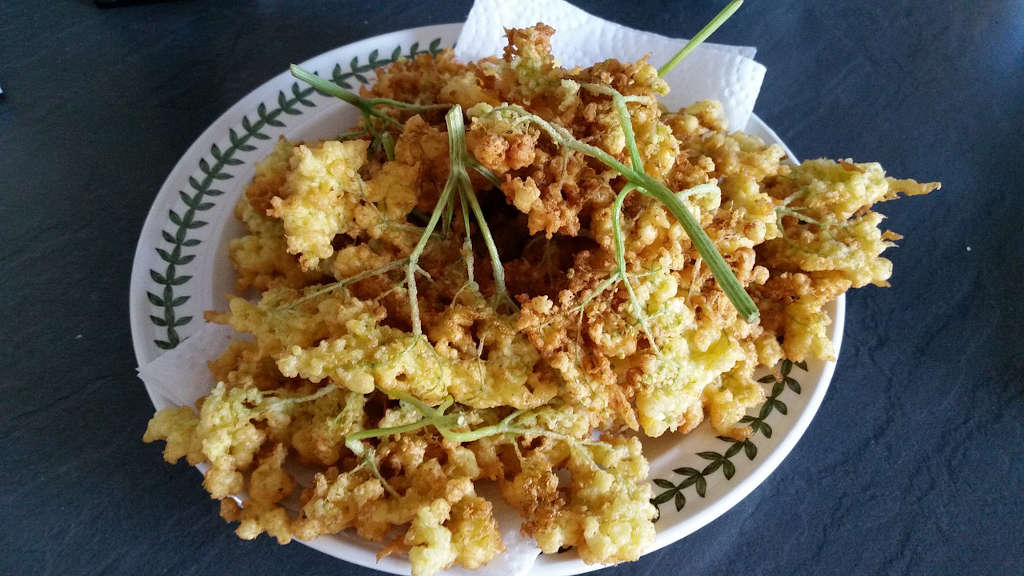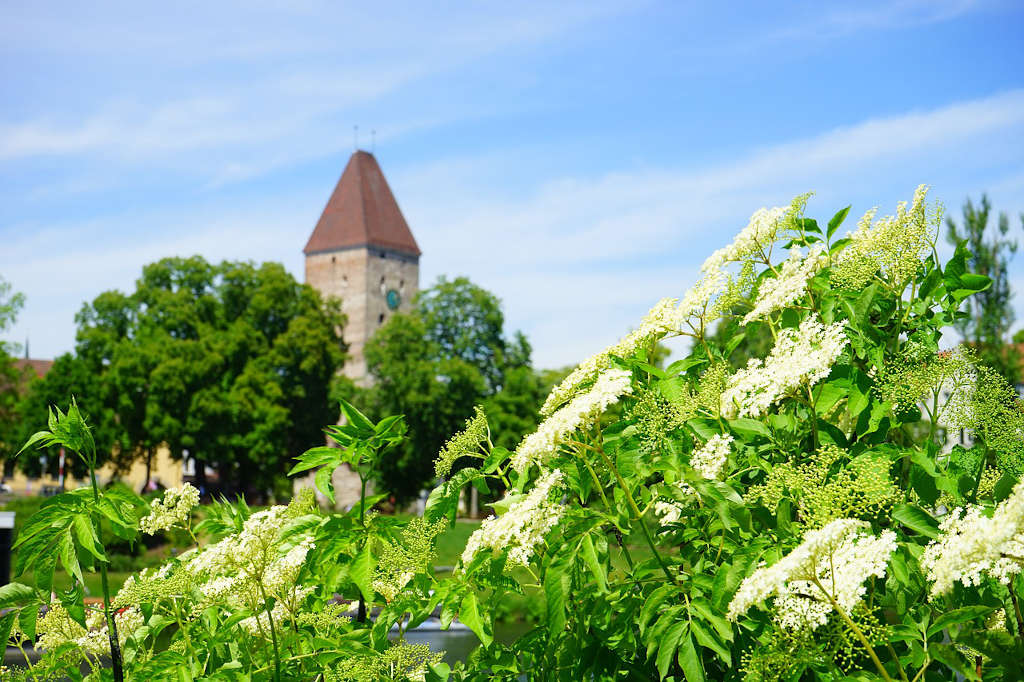
The Elder tree – medicine cabinet of the country people
This much loved, bushy tree is a common sight throughout Britain (especially in southern England) as well as in most parts of central and southern Europe. Its multiple stems branch frequently, giving it a somewhat sprawling appearance. The light grey bark is fissured and covered with many lenticels (breathing pores). The branches are bendy and contain a core of very light, almost cork-like pith, which can easily be removed. Generations of children have taken advantage of this property, making pipes and pop-guns from hollowed-out twigs. The pinnate leaves have opposite, ovate leaflets with serrated margins and one larger terminal leaflet. The flowers appear in May, forming big umbel-shaped bunches of tiny 5-petaled, cream-colored star-shaped flowers. They exude a heavy, sweet, slightly intoxicating scent, especially at dusk. By the end of the summer they develop into drooping bunches of small purple-black berries that are extremely popular with the birds.
HABITAT:
As a nitrogen loving plant Elder commonly grows near farms and homesteads and thrives near organic waste disposal sites. Elder is often grown as a hedgerow bush, since it takes very fast, bends into shape easily and grows quite profusely, hence its reputation as an ‘instant hedge’. It is not fussy about soil type or pH level and will grow wherever it gets enough light.
HISTORY, MYTHOLOGY, AND FOLKLORE
SYNONYMS:
Pipe tree, Ellhorn, Black Elder, Bore Tree, Bour Tree, Eller, Holler, Hylder, Hylantree, Holunder (German), Sureau (French)
The name ‘Elder’ probably comes from the Anglo-Saxon word ‘Aeld’, for ‘fire’, which starts to make sense when we look at another old name for Elder, ‘Ellhorn’. This name derives from the use of hollowed Elder branches as blow furnaces.
Old names, like Holler, Hylder, Hyllantree, and the German word ‘Holunder’ all refer to an ancient vegetation Goddess known in Denmark as ‘Hylde Moer’. In the old days, Elder was considered sacred to this Goddess. Elders were often thought a little spooky. They were believed to be inhabited by a ‘tree dryad’, a kind of tree spirit that represents the soul of the tree, or even an aspect of the Goddess herself. If treated well and respectfully the dryad appeared as a most benevolent spirit that blesses and protects those who care for it. Elders often grow close to human habitations and since they never get struck by lightning, they were thought to protect the homestead against this danger as well. There has long been a widespread taboo against cutting down Elder trees or burning any of their wood. It was thought that the dryad would take revenge and punish the offender with bad luck – or, toothache (Romania). According to ancient folk beliefs, toothaches are seen as ‘supernatural’ and understood as a form of divine punishment. The only legitimate reason for cutting down an Elder tree or to take any part of it, was to use it for medicine, or as a protective charm. To this end, the dryad was asked reverently and asked for permission.
With the head bared and arms folded, the following was recited:
‘Lady Ellhorn, give me some of thy wood, and I will give thee some of mine when it grows in the forest.’
With the rise of Christianity and the subsequent persecution of any form of tree worship the sacred Elder tree became a witches tree and the old stories were reframed to suit the narrative of the new religion. In Christian mythology, Elder was portrayed as a tree of sorrow, because Judas was said to have hung himself from the branches of an Elder tree and this is supposed to be the reason for its stooped appearance and bendy branches: never again should anyone commit suicide with the help of an Elder tree. And to make matters worse, the cross upon which the Savior was crucified was said to have been fashioned from Elder wood. Such a disgrace the Elder tree could not bear and so it has never again been able to grow upright and tall as other trees do.
Nevertheless, some of the older beliefs have lived on and country folk continued to use Elder for protection of house and barn. They pinned the leaves above the doors to ward off evil witches, daemons, and other nefarious influences.
During the Middle Ages such folk magic was practiced all over Europe and many curious customs evolved as pre-Christian and Christian believes got muddled and merged. But without the proper context of the ancient beliefs they turned into superstitions, For example, it was thought that witches and sorcerers could be revealed if one was to cut the inner pith of the twigs to make flat disks. These were dipped in lamp oil and set alight to float them in a glass of water. However, the magic trick only worked on Christmas Eve.
Conversely, one could also use the Elder to enlist the devil for one’s own purposes. On the January 6th (Bertha Night), when the devil is said to go about ‘with special virulence’, one could try to obtain some of his ‘Mystic Fernseed’, which was believed transfer the strength of 30 or 40 men, to the keeper, protect furniture from woodworm, repel snakes and mosquitoes and cure toothaches. To obtain this magic substance, one must cast a magic circle for protection, the boundary of which one must not be broken under any circumstances. Further protection was offered by carrying some Elderberries that had been gathered on St. John’s night. But since Elderberries are not ripe at this time of the year this practice appears a little spurious. A more likely version of this ritual recommends casting the circle with a magic wand made of Elder wood.

Elderflowers
Note: In the old religion the 12 nights of Christmas were regarded as the turning point of the year when the battle between light and darkness culminates and the Sun is reborn. They correspond to the 12 days of midsummer, at the summer solstice, which in the Christian calendar is celebrated on St John’s Day. These periods were the most important time in the ancient pre-Christian ritual calendar. It was said that at these times the veils between the worlds are thin and spirits come and go easily between the spheres of existence. It is for this reason that superstitious practices involving clairvoyance and fortune-telling were often practiced at these times.
Elder’s reputation to offer protection against evil spirits seems to be ubiquitous and can be found from Russia to Romania and from Sicily to Scotland. A less common custom comes from Serbia, where Elder twigs used during nuptial rites, were believed to bestow good luck to the newly-weds. More recently, in Victorian Britain, it was thought that a couple who shared a glass of Elder-infused Ale would marry within a year.
The ancient vegetation Goddess presided over the cycle of life, from the cradle to the grave. However, she was also believed to bestow the power of regeneration and ultimately, of rebirth. Her rhythms were reflected in the waxing and waning of the moon and the cycles of the seasons. As above, so below, as within, so without. Naturally, her rhythms were also applied to the human life-span. Thus, the Goddess of life is also the Goddess of the Underworld, who protects and regenerates the souls of the departed. At funerals, green Elder twigs were often placed into the coffin for protection on the journey to the Otherworld. Christian and pre-Christian beliefs often merged into compounded folk customs with elements of both traditions. In Tyrol for example, Elders were planted on graves and trimmed into the shape of a cross. When the tree starts to flower, the soul was believed to be happy.
An interesting custom from Romania illustrates the Goddess’s power of regeneration. At Easter it was customary to sacrifice a pig. The pig’s inedible remains were given a ceremonial burial and an Elder-tree was believed to sprout from its grave in the following year. Easter/ Spring Equinox is the time of regeneration, the time when the Earth-Goddess awakens the land and blesses the people with her abundant gifts. Both pigs (as an emblem of self-sacrificing motherhood and the principle of nurture) and Elder trees were deemed sacred to this ancient Goddess on account of their obvious attributes of abundance and fertility.
In Denmark, Hylde-Moer, as the Goddess was known, presided over the fairy realm. Fairies are creatures of the Otherworld, but from time to time, especially at the summer solstice, they venture into our world. To watch them on their way to their Midsummer night’s feast, one could hide out in a grove of Elder trees. (Drinking ample quantities of freshly made Elderflower champagne whilst hiding in the bushes might enhance the experience).
Elderberries
The Elder tree has often been described as the medicine chest of the country folk. But even today modern herbalists employ many of its medicinal uses. In 1644 a book dedicated entirely to the virtues of the Elder was translated from Latin to English: on 230 pages the author sings its praises. The book was so popular that it ran through several editions in both its English and Latin versions. According to the author, every single part of the plant was deemed medicinally useful. It even references an edible fungus known as ‘Judas Ear’ (alluding to the above-mentioned myth), which grows on Elder trees. It should come as no surprise that its medicinal powers were said to be effective for quinsy, sore throat, and strangulation (!).
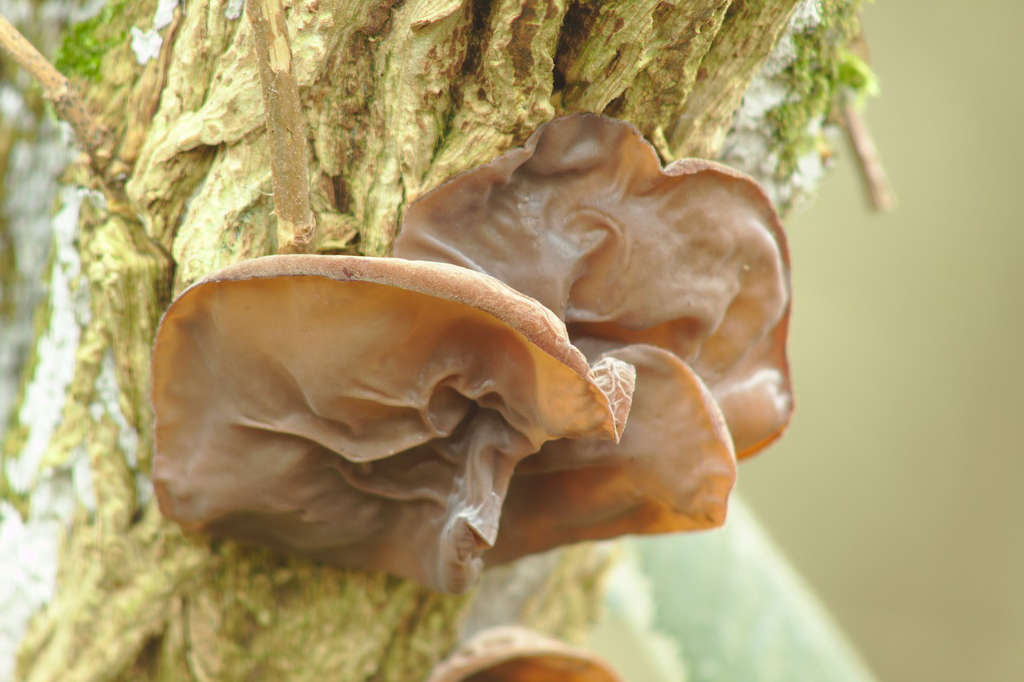
Judas-Ear fungus
The elder itself was considered a panacea capable to relieve almost any ailment, ‘from toothache to the plague’. It seems like a whole apothecary could be stocked solely from the many preparations that could be produced from its various parts: ‘a rob or syrup, a tincture, a compound mixture, an oil, or ointment, a distillation, and a distilled flower water, a liniment, an extract, a salt, or a conserve, a vinegar, an oxymel, a sugar, a decoction, a bath additive, a cataplasm, and a powder’, made from one, several, or all parts of the plant. However, in the old days, it wasn’t just the biochemical activity that was considered medicinally active. The plant’s subtle energy also played an important role, especially in the many folk healing practices that were based on sympathetic magic.
Rheumatism, for example, could be treated with a charm or amulet that was made by tying several knots into a young Elder-twig. This charm had to be kept close to the body to unfold its power. Elder was also believed to cure warts: the wart was to be rubbed with a freshly cut twig, which was not carelessly discarded, but buried in mud, where it was left to rot. Other, more forms of ‘transfer magic’ were also common. The imagination at the root of such practices was that trees in particular are much stronger and resistant than the feeble human body. They were thought capable of absorbing and thereby to neutralize the evil energies that were thought responsible for the disease. Many trees were used similarly, depending on the symptoms of the disease and the availability of various species of trees.
CONTEMPORARY MEDICINAL USES
Elderflowers and berries are still used modern herbal medicine but since heroic medicine went out of fashion, the use of other parts, such as the leaves or inner bark, has been discontinued.
PARTS USED:
Flowers: dried or fresh
Berries: best preserved as cordial, syrup or wine
CAUTION:
The fresh roots of the American Elder (Sambucus canadensis), which closely resembles Sambucus nigra, are extremely poisonous and can cause death if ingested.
Native Americans value a close relative of Sambucus nigra known as ‘American Elder’ (Sambucus canadensis), with very similar medicinal properties. Many of its reported uses closely resemble those of S. nigra in the Old World.
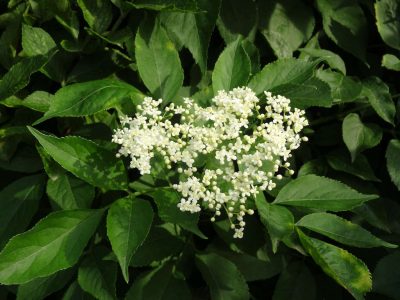
FLOWERS
HARVEST TIMES: Early summer
CONSTITUENTS: Triterpenes, fixed oil containing free acids, alkenes, flavonoids
ACTIONS: Diaphoretic, diuretic, anti-inflammatory, expectorant
INDICATIONS:
Elderflowers have long been used as a treatment for various inflammatory and congestive conditions of the respiratory system, especially when these are accompanied by fever. An infusion is given for cough, colds and flu, asthma, and hay-fever. The diaphoretic action helps to reduce the fever, which makes it useful in the treatment of infectious diseases such as measles, and scarlet fever. Externally, an infusion of Elder-flowers can be added to the bath-water for a wonderfully refreshing effect, to soothe irritable nerves, and to relieve itchy skin. Cooled, the infusion can be used as an eyewash for sore, itchy and inflamed eyes. Earache may be relieved by means of a poultice made from the flowers. For this purpose a small linen bag is filled with the flowers, dipped in hot water, and squeezed to press out any excess liquid before it is applied to the aching ear.
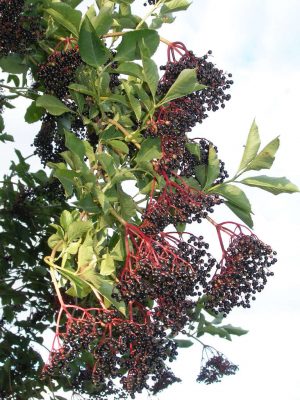
BERRIES
HARVEST TIMES: late summer, early autumn
CONSTITUENTS: Viburnic acid, odorous oil, tyrosin, inverted sugar, tannin, vitamin C and P and B2
ACTIONS: Aperient, diuretic, source of nutrients and vitamins
INDICATIONS:
The berries are rich in vitamins and minerals and are best used as a tonic to ward off winter ailments, which boost the immune system. Vitamin B2 in particular is indicated as effective in the treatment of pneumonia. Elderberries are a valuable alterative remedy that can be used to combat rheumatic conditions. They also soothe sore nerves and help to improve poor circulation.
GENERAL USES
Hedging:
Elder is a familiar hedge plant. The bendy branches can easily be trimmed and laid, thus creating effective protection against wind and erosion. Such a hedge also makes a wonderful wildlife habitat, especially for birds, who love the berries. Country lore testifies to the popularity of Elder as a hedging plant. An old proverb praises its durability:
‘An Elder stake and a blackthorn ‘ether will make a hedge to last forever.’
Tool-making:
Whilst the branches are bendy and flexible, the heartwood and rootstock are extremely strong and have been used for making handles, stakes, fences, combs, and even instruments. According to country lore, a stake of Elder wood driven into the ground will last longer than an iron stake of the same size. ‘The Latin name of the plant, ‘sambuca’ refers not to the high-octane alcoholic drink of the same name (although this too is a product derived from Elder) but to an ancient musical instrument that resembled a harp. It is likely that Elder wood was once used to make these instruments.
Insect and vermin repellent:
Cattle appreciate the presence of Elder in their pasture and seem to instinctively recognize its insect repellent properties. Cows often rub themselves on the stem and branches and stay in its shade to discourage insects. In the past, when fieldwork was still done with the aid of horses, it was a common practice to fixate some Elder leaves to the harness to ward off flies just as fieldworkers fixed the slightly bruised leaves to their hats for the same effect. A decoction of the leaves can be also be used as an insect repellent. The smell of the leaves has been likened to that of mice nests. Mrs. Grieves (A modern herbal) mentions their use for repelling mice and moles.
Young Elder shoots are thought to be effective against blight. A recipe including Elder leaves, iron and copper sulfate, soft soap, nicotine, methylated spirit and slaked lime has been used for this purpose, although organic gardeners just use a decoction made from the young shoots as an insecticide to combat aphids and small caterpillars.
Cosmetics:
In Victorian times, distilled Elderflower water was a highly valued emollient lotion. It was said to cleanse the skin, keeping it young and free of freckles and blemishes. Hard to find, nowadays, but there has been a revival of interest in Elder products and Elderflower water is once again produced commercially.
Dyes:
The bark, leaves, and berries can all be used for dyeing. The bark yields a black dye, a decoction of the leaves with alum produces a green, whilst the berries with alum, dye purple or, if salt is added to the mix, produce a lilac color.
Fodder:
Not all domestic animals are keen on Elder as forage. Sheep and cows don’t seem to mind it, but horses and goats have no taste for it. Sheep suffering from foot-rot are said to deliberately seek out Elder trees for self-medication. Wild birds love the berries, but chickens do not take to them.
Culinary uses:
The best-known culinary uses of Elderflowers and berries are the many delicious drinks that can be made from them. Numerous recipes for country wines, syrups and cordials have never lost their appeal and are still widely used in country areas in Britain and Europe. Such drinks are not simply delicious but are also medicinally valuable.
Elderflower Fritters
The flower heads, dipped in batter and deep-fried, make delicious fritters and can be served with maple syrup and lemon juice.
Hedgerow Jam
The black, fully ripe berries can be made into a delicious hedgerow jam, but the green, unripe berries are poisonous and should be avoided. Even the ripe, fresh berries retain some of this poison, which it is recommended that the berries are not eaten fresh off the bush. They should be heated to 100°C prior to consumption.
